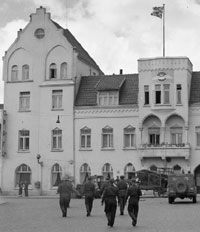
In the last days of the war in Europe, more than a million American soldiers found themselves in defeated Germany. Many were from Northeast Texas, a part of the 36th Division and other units that had landed in Southern France during August 1944. Neither they nor the Germans knew at the time that this was only the beginning of a relationship between the U.S. military and German society that continues to this day. Between 1945 and 1995, more than 23 million Americans came to Germany as soldiers, dependents, or civilian workers.
This lecture examines the critical early days of the American presence. In the months after the end of hostilities, invaders became occupiers. They established social, commercial, employment, and romantic relationships with Germans. American leaders recognized early on that without the active cooperation of German civilians, the occupation had no chance of achieving its goal. Northeast Texas also had an important part of the rebuild effort. Deport native attorney Maurice Thompson “Tex” Moore, then of New York City and president of Time Magazine, was an important cog in the organizing and staffing of the Marshall Plan.
Dr. Seipp will discuss the everyday interactions that characterized the German-American encounter, focusing on the places and spaces where soldiers and civilians found ways to live alongside each other. These contacts, he argues, helped to shape the conditions of that relationship for decades to come.
During the day Dr. Seipp will make a presentation to faculty and students at East Texas A&M Commerce, sponsored by Dr. Sharon Kowalsky, history department head and board member of the WWII Roundtable group. Attendance to the lectures is free.

